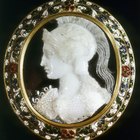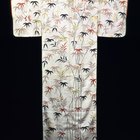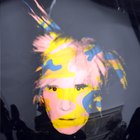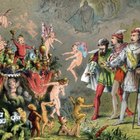The history of bolo ties is an area of heated debate amid the world of men's fashion. The fact is, men around the world have adopted the look and want to call it their own, whether they're Navajo Indians of the American southwest, Argentinean cowboys or rock and roll bad boy Jon Bon Jovi. Sort through this tangled web of stories and legends surrounding bolo ties to determine who can legitimately claim its invention.
History
Many people agree with the version of the bolo tie's history as related by Manny Goodman, the one-time owner of a New Mexican Indian craft store called The Covered Wagon. Goodman shared his recollection of Albuquerque in the 1930s, when Navajo, Hopi and Zuni men began clasping together bandannas around their necks. They used a shell or a silver conch to hold the ends together and to adjust the fit. Other men used a string rather than a bandanna, and the bolo tie look was born. Beyond the southwest, however, Argentine cowboys were wearing their version of the bolo tie, but with leather straps. Other historians point to the American pioneer tradition of wearing kerchiefs or modified ties around the neck during the mid-to-late 1800s.
Expert Insight
Bola Bill Kramer wrote "'Bola Tie: New Symbol of the West" in 1978. In his tome, he shares what he considers the authoritative version of the origins of the bolo tie. He chronicles the story of Victor E. Cedarstaff, a silversmith who lived in Arizona in the 1940s. Cedarstaff and some cohorts were chasing after wild horses when Cedarstaff's silver-bordered hatband slipped off, making his hat fly away as well. He caught up with his hat band and slipped it over his neck for safekeeping. His friends noticed his look and complimented his new tie. Cedarstaff decided to create a line of ties inspired by the incident. He braided leather, placed silver tips on the ends to keep them from fraying and then joined the strands with a turquoise stone to be used as an adjustable clasp. He applied for a patent, calling his creation the bola tie, named after the boleadoras cords worn by Argentine cowboys.
Types
Part of the dispute over the roots of bolo ties stems from its variations. The southwestern United States can lay claim to its Indian and western versions featuring stones of the region and integrating Native American silversmith traditions. Argentina can take credit for the use of three leather straps, known as a lariat style. Then there is the British version, called bootlace ties. These fabric or leather laces may be traditional black or multicolored. People consider them costume wear, although stylish Teddy Boys donned them in the 1950s.
Features
Although it has many variations, the bolo tie shares some characteristics across cultures and eras. It has always been placed beneath the shirt collar, like a traditional tie. A bolo tie must consist of thin, string-like material, which may be like a lace or may be braided. The bolo tips, or ends, are a necessary addition, allowing them to be strung through the bolo slide with ease. The bolo slide is the area of most variation, because it is the most noticeable part of the tie. It may be comprised of stone, metal or plastic. Some slides are geometric while others are shaped like people, animals, natural wonders or abstract shapes. The surface may be engraved, textured or smooth.
Fun Fact
The pop culture history of bolo ties is easier to chronicle. Bolo ties hit the silver screen over the decades, notably in the 1980 film "Urban Cowboy" which had John Travolta sporting a full neo-Western look. Brian Setzer and his band The Stray Cats helped make bolo ties one of the official accessories of the new wave of rockabilly in the mid-1980s. At the same time, the New Romantic boys were swinging bolo ties around Edwardian collar shirts and finishing the look with a vintage suit coat. This look was exemplified by the Duckie character in the John Hughes movie "Pretty in Pink".
Related Articles

What Is a Plastic Shoelace Tip Called?

Why Is It Called a Pea Coat?

How to Date a Brooch

How to Tie a Kimono Belt for a Man

How to Make a Bolo Tie

Hat Trends of the Seventies

Levis Jeans Label History

How to Wear a Cowboy Bandana

What Do Women Pirates Wear?

How to Dress Like Travis Barker

How to Make a King Leonidas Costume

How to Dress Like Andy Warhol

What Is the Difference between a Coat ...

How to Dress Like Johnny Cash

What Did Men Wear in the '50s?

The History of Pinstripe Suits

The History of Denim Jackets

What Did Men Wear During the ...

What Is Pelle Leather?

How to Dress Like Bono
References
Writer Bio
Nina Makofsky has been a professional writer for more than 20 years. She specializes in art, pop culture, education, travel and theater. She currently serves as a Mexican correspondent for "Aishti Magazine," covering everything from folk art to urban trends. She holds a Bachelor of Arts in English from Mills College.